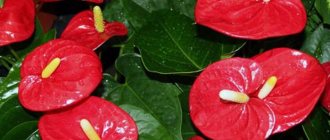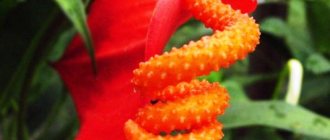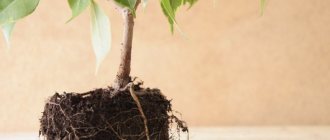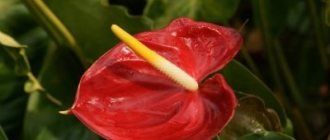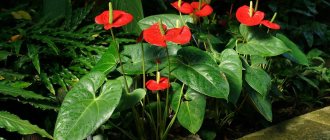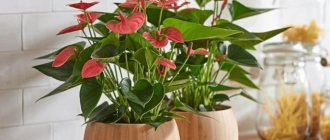Why is rejuvenation necessary?
The older the anthurium gets, the less beautiful it becomes. The lower leaves gradually die off, exposing the unattractive trunk of the plant. Leaves and flowers become increasingly smaller, often growing with curled tips. Sometimes the flowering of anthurium stops completely.
If a flower has lost its decorative appearance and began to wither, then in order to revive it to a new life and again admire the chic flowers of “male happiness”, it is necessary to carry out a rejuvenation procedure.
Reproduction
Anthuriums are propagated by dividing the bush and by cuttings:
- Since the first method is quite traumatic for the root system of the plant, it is used with caution. After the procedure, it is imperative to create favorable conditions for the flower to reduce the adaptation period, such as installing a greenhouse dome or frequent spraying with warm water.
- When cuttings, anthurium takes root in a short time, since the rudiments of aerial roots are already present on the stem.
How often should the male happiness flower be renewed?
A plant that is not yet three years old does not require updating.
As it gets older, the anthurium begins to degrade: the roots and leaves die off, and the plant begins to wither. Growth and development are suspended. Different types of “male happiness” require rejuvenation at different ages, which can be determined by their appearance. As a rule, anthurium that is 4-5 years old needs resuscitation. You can rejuvenate at least every year, but it is best to prune once every 3-4 years. The most favorable time for flower renewal is considered to be from May to June. In summer it is warm and the plant has time to sprout roots before the first cold weather and short daylight hours.
When should you start updating?
To understand that anthurium needs pruning and rejuvenation, just examine it carefully. In an aging plant, as the lower leaves die off, an unsightly trunk is exposed.
Unlike young anthurium, the leaves and flowers of the old plant become small, many side shoots appear and “male happiness” turns into a bush with small flowers, and eventually stops blooming altogether. All these signs indicate that the flower should be rejuvenated.
Diseases and possible pests
Anthurium is rarely affected by disease. All problems with his health often appear due to improper care. It is enough to restore the temperature and light conditions, adjust the humidity and watering for the plant to be revived.
Pests that settle on a flower can cause a lot of trouble.
| Pest | Signs of appearance | Treatment |
| Aphid | The leaves dry out and the plant grows slowly. They settle mainly on the underside of the leaf blade. | Treat the stems and leaves of anthurium with a special insecticide against the parasite. |
| Shields | Beige or brown tubercles appear on the leaves. Easily separated from the surface with a wooden stick. | Water the plant with a solution of a systemic insecticide, for example, Aktara. The substance will be absorbed into the sap of the plant and enter the body of the parasite, thereby neutralizing it. |
| Spider mite | On the surface of the plant you may notice cobwebs or punctures in the leaf blade. | First of all, wash the leaves of the flower with a soapy solution, and then treat with an acaricide. |
| Thrips (small midges) | Microorganisms that can cause a fungus or virus are left on the surface of the leaf plate. As a result, the leaves become pale yellow or white. | Treat the bush with special products. Additionally, sticky traps can be installed. |
| Whiteflies | Butterflies are very easy to spot. They affect the leaf plate, as a result of which the leaves become deformed and lose color. | Treat the plant with special insecticides. |
Step-by-step rejuvenation procedure
It is necessary to rejuvenate “male happiness” in the following way:
- Cut off the upper part of the stem, which has aerial roots, 12-15 cm high, and remove the leaves, leaving two leaves on the cutting.
- At the bottom of a plastic cup with a volume of 200-500 ml, make several holes for water to drain and pour vermiculite into it, filling 1/3 of the container.
- Plant the cut part of the stem into a glass, deepening it by 5 cm, sprinkling vermiculite on top.
- Moisten the vermiculite, spray the leaves, and cover the top with a glass jar, plastic wrap or the cut-off bottom of a plastic bottle so that constant moisture is maintained inside - this will facilitate faster rooting of the plant.
- Place the greenhouse in a bright place, and if there is not enough light, then under a special lamp, maintaining a temperature of 22-24 degrees.
- The planted cuttings must be sprayed daily with soft warm water, the greenhouse must be ventilated, and the vermiculite must not be allowed to dry out.
- The first roots begin to sprout after 20-25 days. When new leaves appear and the roots grow by 3 cm (in one and a half to two months), the greenhouse is dismantled and the rejuvenated plant is planted in a permanent pot with soil.
If after cutting the top there is a trunk and roots left, then do not rush to throw them away. You can try to revive “men's happiness”. To do this, you need to continue to care for the remaining “stump” and reduce watering, since there is no need to feed the leaves. Often, dormant buds wake up on an old plant, from which young shoots develop, and under them - aerial roots.
When the roots grow to 1.5 cm in length, the flower can be transplanted into a new substrate, resulting in another updated anthurium.
How to rejuvenate an old anthurium at home
When is it time to rejuvenate
There are several visible signs indicating that it is time to renew your anthurium.
An old plant either stops blooming altogether or blooms with small flowers, and its leaves also become smaller. On an ugly thick trunk, the lower leaves die off, while new leaves grow upward quite actively. Some plants develop many lateral shoots; the anthurium becomes like a branched bush with numerous small flowers.
The best time to re-root this flower is May and June. During these months it is already quite warm, the flower will have time to take root and gain strength before the first autumn cold.
Next, we will take a closer look at how to rejuvenate anthurium at home.
Step-by-step instruction
Even a novice florist will be able to cope with this task if he follows the instructions step by step.
The rejuvenation procedure is as follows:
- Take garden shears. The trunk of the plant should be trimmed so that 5–7 aerial roots remain on it.
- Old scales are removed from the cut stem.
- Anthurium is placed in a container of water, where a growth stimulator (Kornevin) is added. The growing point should remain above the water.
- In this way, you can rejuvenate all old plants that have aerial roots. But before planting a home flower, it must grow its underground roots.
The stems are placed in a separate container, from where they can be conveniently taken out. It is important not to damage the fragile aerial roots of the cut anthurium.
How to grow roots
It is necessary to grow anthurium roots in a small container, or in a glass. It should be of such a size that the roots fit, but there is still a small gap at the walls. A small hole is made at the bottom of the container and a drainage layer is placed. A glass with transparent walls is convenient because you can see when the roots grow to the desired size (3 cm).
Not only the capacity matters, but also the correct soil. Perlite or vermiculite is added to it, which will serve as a leavening agent. The soil must be moist and must be maintained in this condition all the time. It is important that the cutting does not dry out during rooting.
To create suitable conditions for the plant, it is covered with a jar, film or cut plastic eggplant. The “greenhouse” is placed in a place where there is a lot of diffused light.
What to do with the stump after trimming
After the pruning procedure, a stump without leaves may remain in the flowerpot, but it can be “awakened”. Over time, the stump is able to produce new shoots and roots. For this reason, it is used to propagate anthurium.
The cut area must be treated with activated carbon. You can also use brilliant green for processing. When planting, the stump is completely buried in the ground.
Photos of flowers after resuscitation
Care after pruning
After pruning and rejuvenation, the plant requires the same care as for a newly transplanted anthurium:
- The ambient temperature should be from 18 to 22 degrees;
- place the plant away from drafts;
- place the flowerpot in a well-lit place, but not in direct sunlight;
- Water the anthurium regularly, but do not over-moisten the soil;
- Provide good drainage to remove excess water.
If you follow simple rules of care, updating an old anthurium will be successful, even if what remains of the gorgeous flower is a trunk with several leaves.
How to update an anthurium at home?
Without updates there is no development - read today’s article on how to update an anthurium at home? How to properly care for anthurium at home to prolong its development?
How to update an anthurium at home?
Anthurium is a South African original plant. Among other exotic representatives, anthurium stands out for its unusual modified leaf inflorescence - its active color causes a surge of strength, awakening hidden energy, which is why anthurium has always been considered a male plant. Updates extend life - how many years does anthurium live at home? You can enjoy flowering longer than the established limit if you choose the right renewing care.
How to update an anthurium at home:
- Trim.
- Propagate.
- Remove side shoots during replanting.
The traditional way to renew a plant is to prune . The top of the anthurium is cut off, then it is rooted if necessary, thus performing 2 procedures at once - renewal and reproduction.
How to cut the top of an anthurium:
- Count 9-11 cm from the top.
- Cut horizontally, removing the top.
- Plant in moss or poor substrate.
Transplantation for further propagation is carried out in a mixture of bark, vermiculite, moss and coconut fiber. The apical shoot of the anthurium should form roots during the first germination - now they completely go into the new substrate. Reproduction and rooting of anthurium will not take much effort. The next stage is home care. Start with moderate watering so as not to oversaturate the stunted plant with moisture.
Removing side shoots is another way to renew anthurium at home. In this case, the florist resorts to a double procedure: transplantation + pruning of the lateral roots. Their removal will stimulate the renewal of anthurium, returning strength and former vitality. Having felt “relief”, the anthurium will begin to intensively form new shoots, which will improve the development of roots.
Transplanting into a fresh substrate and a larger pot will complete the transition process of renewal and help the anthurium to recover quickly. In this case, it is also important not to overwater the anthurium so that the treated roots do not rot. After trimming, be sure to sprinkle them with dry wood powder.
Anthurium care - additional updates
You can only renew an anthurium at home in a comprehensive manner - for this, after the first of the selected renewal procedures, suitable care is introduced. Without it, the entire recovery system collapses.
How to care for anthurium after updates:
- Create humidity 70%.
- Diffused lighting before restoration.
- Drain the water from the pan.
- Do not place in a draft after watering.
- Moisten with settled water.
- Air temperature +23° C.
Is it possible to feed anthurium at home to renew it? Naturally, fertilizers will stimulate anthurium renewal, but there is no need to feed the plant immediately after replanting, pruning and propagation - let it recover for up to 1.5 weeks. After a period of rest, add complex mixtures: nitrogen + potassium + phosphorus.
Anthurium can also be kept according to the principle of orchids , and fertilizers for this type of plant are also suitable for African flowers - you choose what to saturate the plant with.
↓ Write in the comments how you updated the anthurium at home?
Please rate the material you read :)
What to do if the plant withers after the procedure?
If the plant was pruned correctly and its rooting was successful, but the anthurium soon began to wither, then some mistakes may have been made in caring for the renewed plant.
A renewed plant may begin to wither if:
- it is exposed to direct sunlight or, conversely, insufficient lighting;
- high room temperature and dry air;
- excess nitrogen fertilizers;
- excessive or insufficient watering.
When all these problems are eliminated, the plant should return to normal and begin to grow. If the leaves still do not rise, then we can assume that the flower was infected with chlorosis or fusarium during transplantation. In the first case, iron should be added when applying fertilizer, and in the second, the anthurium should be treated with fungicides.
Attention! Sudden changes in air temperature, as well as drafts, should not be allowed - this can cause the plant to die.
The procedure for rejuvenating a plant does not require significant effort, and all of the above tips will help you avoid typical mistakes of a novice gardener.
How to properly replant anthurium at home?
Such a beautiful flower as anthurium is often compared to a flamingo, emphasizing its graceful inflorescences located on long peduncles. In addition to flowering varieties, there are also decorative forms of this plant that have original leaves. In its homeland, in South America, anthurium grows on branches, tree roots and below, under the crowns.
At home, this flower is not able to lead such a lifestyle, but is kept on window sills in pots. To achieve spectacular flowering, the plant must be carefully cared for and periodically replanted. So how to transplant an anthurium correctly and without damaging it?
Reasons and methods of transplantation
Most often, it is recommended to replant anthurium for the following reasons:
- filling the earthen coma with roots and cramping the old pot,
- incorrectly selected soil, which negatively affected the condition of the plant,
- diseases of the root system and the formation of rot on it.
Depending on the reason, replanting a plant at home should be carried out by transferring it into a new pot with updating the substrate, or the flower is transferred, having previously cleared it of the old soil.
Relocation due to lack of free space
If thick roots appear from the drainage holes and above the soil surface, the anthurium should be replanted. Inside the container, the plant no longer has enough free space , as a result of which the roots begin to move out, trying to get moisture and nutrition from the air.
To prevent damage to the root system during replanting, the flower should be watered abundantly before replanting. This makes the soil softer and makes it easier to remove the earthen ball from the pot. If the container is plastic, you can lightly tap it on the edge of the table. After this, the anthurium is removed, the roots are carefully examined and transplanted into a new pot.
The container should be chosen so that it is not much wider than the previous one. It is best if its height is equal to its diameter . If the pot is too wide, the plant will have to wait a long time for flowering. Until the root system grows into the new soil, flower buds will not form.
When replanting an anthurium, it is necessary to place an earthen lump braided with roots in the center of the pot, and the gaps that arise on the sides are filled with fresh soil, which is compacted a little, being careful not to accidentally touch the rhizomes. The top layer should also be updated and, if necessary, watered, after which the surface of the soil is covered with sphagnum to retain moisture.
After transplantation, the anthurium at home acclimatizes quite quickly and after a while you can expect the appearance of new leaves and inflorescences.
Replanting due to improperly selected soil
If the grower makes a mistake with the choice of soil , then very soon this will affect the plant itself:
- his health will deteriorate,
- growth will stop
- decorativeness will disappear.
That is why the anthurium should be transplanted into new soil.
It must be remembered that such a flower feels good only in a very light and loose substrate, so the ideal soil is one that easily allows water and oxygen to pass through. In this case, the roots easily penetrate into the soil, receiving plenty of water and nutrition.
There are many recipes for preparing soil mixture for anthurium. You can use a ready-made mixture for orchids , to which crushed charcoal and a small amount of turf soil are added. It is often recommended to mix peat, crushed sphagnum and coconut fiber in equal parts for anthuriums. You can also purchase a ready-made specialized substrate for such flowers.
If it is difficult to find certain components, the top soil layer from a coniferous forest is used to replant this plant. Before use, such natural raw materials must be thoroughly disinfected to exclude the possibility of infection of anthurium by fungi and soil pests.
Transplantation due to emerging diseases
- spots appear on leaves and stems,
- the foliage began to fade,
- cessation of flowering and slowing growth.
If even after watering the anthurium could not restore its former attractiveness, it must be urgently replanted . The plant may also suffer from an excess of moisture in the soil or, conversely, as well as from too dense soil and the invasion of various pests.
Before transplanting a flower at home, it should be watered and then removed from the pot. The old soil must be cleaned off, protecting the root system and inspecting it. If the roots are rotten or damaged, such areas should be carefully trimmed back to healthy white tissue, and the sections should be treated with activated charcoal or charcoal powder.
Dry or lost leaves should also be removed, and the inflorescences should be cut off along with the peduncles. This is necessary in order to reduce the load on the weakened plant, and it will quickly overcome the shock associated with the transplant. A flower that has traces of rot should be treated with a fungicide .
After transplanting an anthurium that has suffered from root rot, late blight or other diseases, it is necessary to monitor its condition and, if necessary, re-treat the root system, crown and soil.
Anthurium transplant after purchase
After purchasing this plant from a store, it must be replanted immediately. This is explained by the fact that flowers intended for sale are grown in pots with a small amount of coconut or peat substrate , which is seasoned with long-acting fertilizers.
In this case, the anthurium’s food supply is only enough for two months. After the flower gets into home conditions, it begins to run out of its last strength. Therefore, if it is not transplanted into fresh soil after purchase, the anthurium may die.
First, all flower stalks are cut off from the plant to facilitate its acclimatization after replanting, then it is removed from the pot and transferred to nutritious, complete soil.
The transplanted flower must be properly cared so that it gains strength and delights with its magnificent flowers.
The anthurium should not be watered until the top layer of substrate underneath has dried out. Do not create drafts and protect from direct sunlight. Since fresh soil contains all the necessary nutrients, fertilizing is carried out only after 2 - 3 months. If this is done earlier than the specified period, mineral and organic substances that have entered the soil can cause burns to damaged tissues, which will cause severe discomfort to the flower.
Thus, we have found out what an anthurium flower is, replanting it at home is extremely necessary, especially if the plant was purchased in a specialized store. Planted in fresh soil, after a while it is quite capable of delighting with its beautiful flowers.

